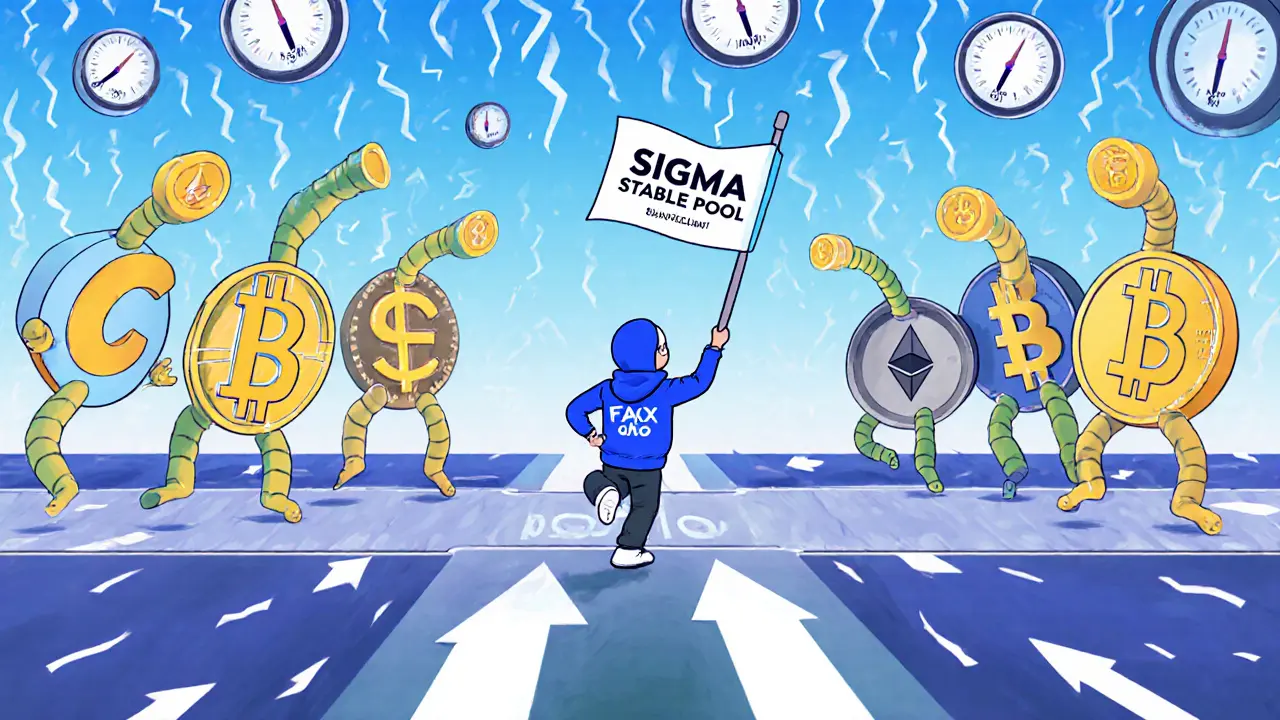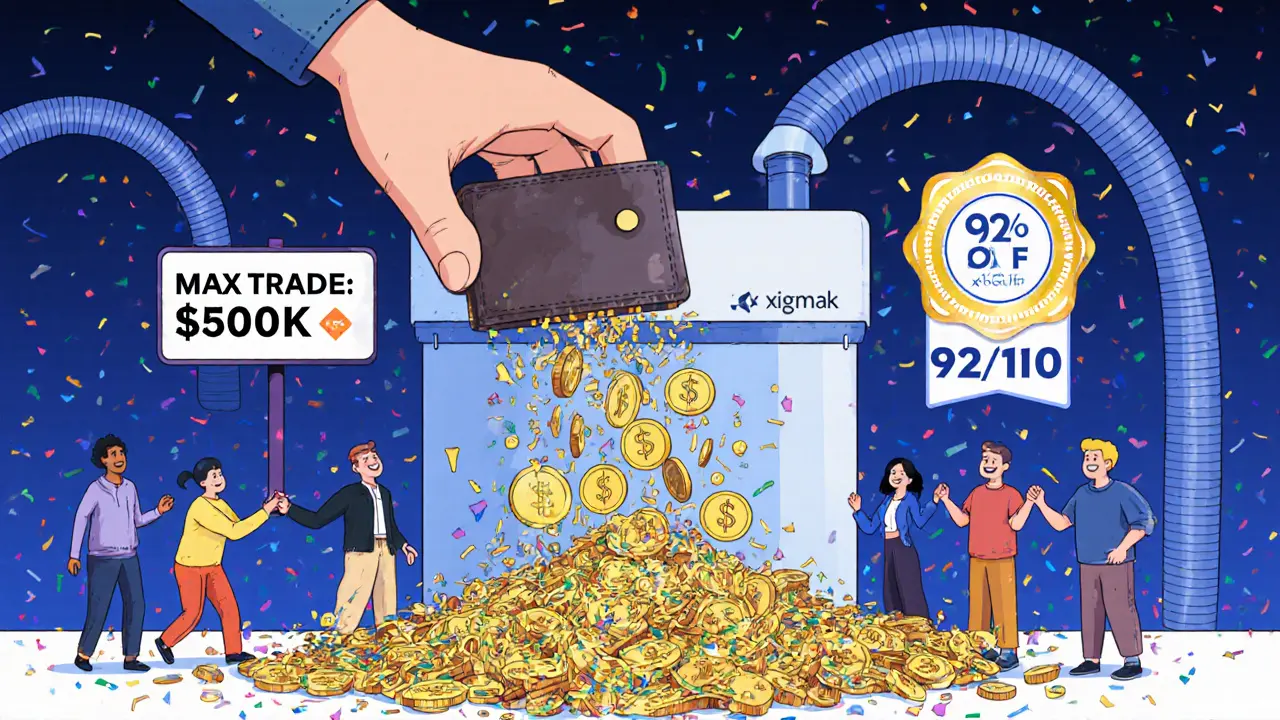Stablecoin Swap Savings Calculator
Calculate your potential savings when swapping stablecoins using xSigma DEX versus Curve Finance. The calculator shows how much you'd save on slippage fees for your trade size.
Your Savings
xSigma DEX: 0.02% - 0.05% slippage
Curve Finance: 0.15% - 0.25% slippage
For a $ swap:
xSigma DEX isn’t another generic crypto exchange. It doesn’t let you trade Bitcoin, Ethereum, or meme coins. It does one thing, and it does it better than almost anyone else: swaps between stablecoins with almost no slippage and rock-bottom fees. If you’re moving USDC to USDT, DAI to FRAX, or GHO to USDe - especially in large amounts - xSigma isn’t just an option. It’s the most efficient tool you’ll find.
Why xSigma Exists
Most decentralized exchanges treat stablecoins like any other asset. They use the same AMM models for ETH/USDT swaps as they do for USDC/DAI. That’s a problem. Stablecoins don’t swing like volatile tokens. They’re meant to stay at $1. But when you try to swap $50,000 of USDC for USDT on Uniswap or Balancer, you get hit with 0.3% to 1% slippage. That’s $150 to $500 lost on a single trade. For institutions and active traders, that’s unacceptable. xSigma was built by ex-Circle and MakerDAO engineers who saw this gap. They didn’t want to compete with Uniswap. They wanted to fix what Uniswap got wrong for stablecoins. Launched in late 2023, xSigma is a DEX built from the ground up for stablecoin liquidity. It’s not trying to be everything. It’s trying to be the best at one specific, critical task.How xSigma Works
xSigma uses a hybrid model that blends the best of AMMs and order books. For small trades under $10,000, it uses concentrated liquidity pools - similar to Uniswap V3 - but tuned specifically for stablecoin pairs. For larger trades, it routes orders off-chain through its proprietary solver network, then settles them on-chain. This means you get the price accuracy of an order book without sacrificing decentralization. Its v2.3 protocol, live since March 2025, has three key layers:- Concentrated Liquidity Pools for major pairs like USDC/USDT and DAI/USDC, with tight price ranges that keep spreads narrow.
- Cross-Chain Routing that pulls liquidity from Ethereum, Arbitrum, and Polygon in real time. If Arbitrum has deeper USDT liquidity, it uses that - automatically.
- Sigma Stable Pool, a custom pool with dynamic fees. When volatility spikes (say, during a Fed announcement), fees adjust upward to protect liquidity providers. When things are calm, fees drop, making swaps cheaper.
Gas Fees? Nearly Gone
Trading on Ethereum used to mean paying $2-$5 per swap. xSigma slashes that. Its batch settlement system groups dozens of trades into one transaction, spreading the gas cost across users. On Ethereum mainnet, the average fee is now $0.85. On Arbitrum, it’s often under $0.30. That’s 35-45% cheaper than the DEX average. Even better, xSigma integrated EIP-4844 (proto-danksharding) in October 2025. This cuts gas costs another 22-35% for users, especially on large swaps. It’s one of the first DEXs to adopt this upgrade, and it’s already making a difference.Stablecoins Supported
xSigma supports 12 regulated, fully backed stablecoins:- USDC
- USDT
- DAI
- FRAX
- USDe
- GHO
- LUSD
- USDN
- USDP
- DAI+ (synthetic)
- USDS
- USDD

Minimums, Maximums, and KYC
You can start trading with just $100. There’s no KYC. No account creation. Just connect your wallet - MetaMask, WalletConnect, or Ledger - and go. Maximum single trade? $500,000. That’s enough for retail traders and small funds. Institutions can use the upcoming API service (coming Q4 2025) for larger, automated flows. No KYC means no limits on who can use it. But it also means no chargebacks, no customer support for lost funds, and no insurance. You’re fully responsible. That’s standard for DeFi - but worth remembering.The $SIGMA Token
xSigma’s native token, $SIGMA, isn’t just for speculation. It’s the engine that powers the platform:- Fee Discounts: Staking $SIGMA gives you up to 50% off trading fees.
- Liquidity Mining: Provide liquidity to xSigma pools and earn $SIGMA at APRs between 3.5% and 8.2%, depending on the pair and chain.
- Governance: Holders vote on protocol upgrades, fee structures, and new stablecoin listings.
How It Compares
| Feature | xSigma DEX | Curve Finance | Balancer | Uniswap |
|---|---|---|---|---|
| Slippage (on $100k swap) | 0.02% - 0.05% | 0.15% - 0.25% | 0.3% - 0.5% | 0.5% - 1.2% |
| Gas Cost (Ethereum) | $0.85 | $1.80 | $2.10 | $2.30 |
| Stablecoin Pairs | 15 | 12 | 8 | 12% of volume |
| TVL | $412M | $2.1B | $890M | $3.2B |
| Cross-Chain Routing | Yes (Ethereum, Arbitrum, Polygon) | No | Yes (limited) | Yes (manual bridge) |
| KYC Required | No | No | No | No |
| Max Single Trade | $500,000 | $1M | $250,000 | $100,000 |

Who It’s For (And Who Should Avoid It)
Use xSigma if:- You trade stablecoins daily or weekly.
- You move $10,000+ in a single swap.
- You care about saving $100+ per trade.
- You use Ethereum, Arbitrum, or Polygon.
- You want to stake $SIGMA for fee discounts.
- You want to trade Bitcoin, Ethereum, or altcoins.
- You need 20+ stablecoin options (try Eco Portal instead).
- You’re new to DeFi and don’t understand wallet security.
- You expect customer support to recover lost funds.
Real User Experiences
Trustpilot gives xSigma a 4.3/5 from 87 verified reviews. Common praise: “Lowest fees I’ve ever seen,” “No more slippage nightmares,” and “Simple interface for cross-chain swaps.” On Reddit, users like u/CryptoArbMaster have documented $250,000 swaps with 0.04% slippage - saving $450 compared to Curve. That’s real money. But it’s not perfect. Negative feedback points to:- Occasional route failures during Ethereum gas spikes.
- Limited stablecoin selection (only 12 vs 20+ on some platforms).
- Minor UI quirks when setting custom slippage.
Future Roadmap
xSigma isn’t standing still. Its Q4 2025 roadmap includes:- Support for 20+ stablecoins (matching Eco Portal).
- Institutional API for treasury management and automated swaps.
- Permissioned liquidity layer for regulated financial firms.
- $SIGMA v2.0 token upgrade with quadratic voting and revenue sharing.
Final Verdict
xSigma DEX isn’t for everyone. But if you’re serious about stablecoin trading - whether you’re a retail trader, a DeFi power user, or a small treasury team - it’s the best tool on the market. It solves a real, expensive problem that bigger exchanges ignore. Slippage is a silent killer in DeFi. xSigma turns that killer into a whisper. Gas fees? Almost gone. Cross-chain routing? Automatic. Security? Audited by CertiK with a 92/100 score. And the team is building fast. It’s not the biggest DEX. It’s not the flashiest. But for stablecoin swaps, it’s the most efficient. And in crypto, efficiency is everything.Is xSigma safe to use?
xSigma has been audited by CertiK with a score of 92/100. It uses multi-signature treasury controls and circuit breakers to prevent exploits. The platform is non-custodial - you control your keys. But like all DeFi platforms, you’re responsible for your own security. Never share your seed phrase, and only use trusted wallets like MetaMask or Ledger.
Can I trade Bitcoin or Ethereum on xSigma?
No. xSigma only supports stablecoin pairs. It’s designed specifically for USDC, USDT, DAI, FRAX, and other $1-backed tokens. If you want to trade volatile assets, use Uniswap, PancakeSwap, or another general-purpose DEX.
How do I get started with xSigma?
Connect your wallet (MetaMask, WalletConnect, or Ledger) to the xSigma website. Approve the stablecoin you want to swap (like USDC), set your slippage tolerance (default is 0.1%), select your target stablecoin, and click swap. The first trade takes about 3 minutes. After that, it’s under a minute.
What’s the minimum trade size?
You can start with $100. There’s no lower limit beyond that. The platform is optimized for trades above $10,000, but even small swaps benefit from the low slippage and gas savings.
Is xSigma better than Curve Finance?
For stablecoin swaps, yes - especially for larger amounts. xSigma has lower slippage (0.02%-0.05% vs Curve’s 0.15%-0.25%), lower gas fees, and better cross-chain routing. Curve has more TVL and more liquidity, but xSigma is more efficient. If you’re swapping $50,000+ weekly, xSigma saves you hundreds in fees.
Do I need to stake $SIGMA to use xSigma?
No. You can trade without staking $SIGMA. But if you want to cut your trading fees by up to 50%, staking is worth it. The APR for liquidity mining ranges from 3.5% to 8.2%, so you can earn passive income while providing liquidity.
What networks does xSigma support?
As of October 2025, xSigma operates on Ethereum mainnet and Arbitrum, with cross-chain routing to Polygon. Base and Optimism are planned for Q3 2025. All trades settle on-chain, but routing is optimized across chains to find the best price and lowest cost.
Why does xSigma have fewer stablecoins than other platforms?
xSigma only lists stablecoins with public audits and transparent reserves. This reduces risk. Many platforms list tokens with questionable backing. xSigma avoids that. They plan to expand to 20+ tokens by Q4 2025, but only if they meet strict transparency standards.
